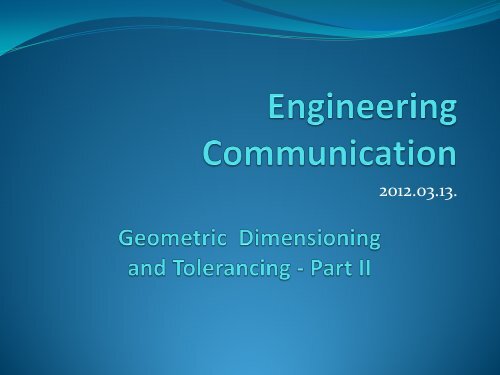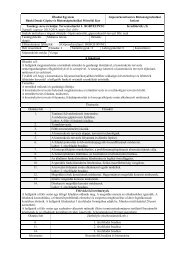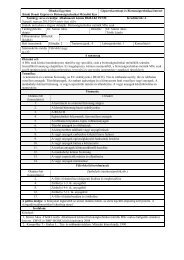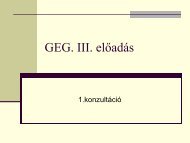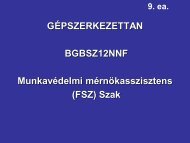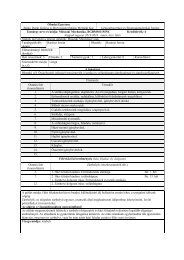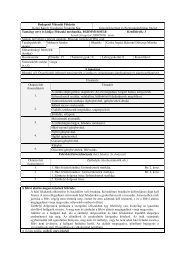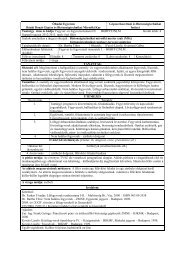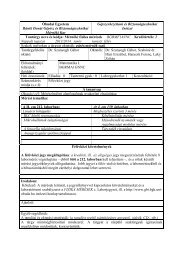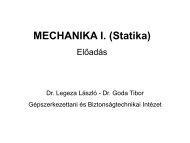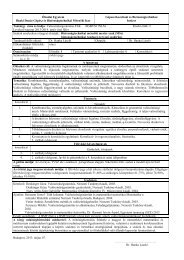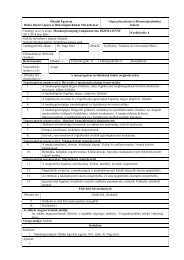Datums
Datums
Datums
Create successful ePaper yourself
Turn your PDF publications into a flip-book with our unique Google optimized e-Paper software.
2012.03.13.
Categories of Dimensioning<br />
Features requiring datum reference<br />
‣ Orientation<br />
• Perpendicularity<br />
• Angularity<br />
• Parallelism<br />
‣ Runout<br />
• Circular Runout<br />
• Total Runout<br />
‣ Location<br />
• Position<br />
• Concentricity<br />
• Symmetry
Geometric Dimensioning & Tolerancing (GD&T)<br />
<strong>Datums</strong><br />
‣ <strong>Datums</strong> are features (points, axis, and planes) on the<br />
object that are used as reference surfaces from which other<br />
measurements are made.<br />
‣ They are used in designing, tooling, manufacturing,<br />
inspecting, and assembling components and subassemblies.<br />
1.000
Geometric Dimensioning & Tolerancing (GD&T)<br />
<strong>Datums</strong><br />
‣ Features are identified with respect to a datum.<br />
‣ Always start with the letter A<br />
‣ Do not use letters I, O, or Q<br />
‣ May use double letters AA, BB, etc.<br />
‣ This information is located in the feature control<br />
frame.<br />
‣ <strong>Datums</strong> on a drawing of a part are represented using<br />
the symbol seen below.
Geometric Dimensioning & Tolerancing (GD&T)<br />
Datum reference symbols<br />
‣ The datum feature symbol identifies a surface or<br />
feature of size as a datum.<br />
A<br />
ANSI<br />
1982<br />
A<br />
ASME<br />
1994<br />
A<br />
ISO
Geometric Dimensioning & Tolerancing (GD&T)<br />
Placement of datums<br />
‣ <strong>Datums</strong> are generally placed on a feature, a centerline,<br />
or a plane depending on how dimensions need to be<br />
referenced.<br />
A<br />
OR<br />
A<br />
A<br />
ANSI 1982<br />
ASME 1994<br />
Line up with arrow only when<br />
the feature is a feature of<br />
size and is being defined as<br />
the datum
Geometric Dimensioning & Tolerancing (GD&T)<br />
Placement of datums<br />
‣ Feature sizes, such as holes<br />
A Ø .500±.005<br />
‣Sometimes a feature has a GD&T and is also a datum<br />
A<br />
Ø .500±.005<br />
Ø .500±.005
Geometric Dimensioning & Tolerancing (GD&T)<br />
Example <strong>Datums</strong><br />
‣ <strong>Datums</strong> must be perpendicular to each other<br />
• Primary<br />
• Secondary<br />
• Tertiary
Geometric Dimensioning & Tolerancing (GD&T)<br />
Primary datum<br />
‣ A primary datum is selected to provide functional<br />
relationships, accessibility, and repeatability.<br />
• Functional Relationships<br />
• A standardization of size is desired in the manuf. of a part<br />
• Consideration of how parts are orientated to each other is<br />
very important<br />
• For example, legos are made in a standard size in order to<br />
lock into place. A primary datum is chosen to reference the<br />
location of the mating features.<br />
• Accessibility<br />
•Does anything, such as, shafts, get in the way
Geometric Dimensioning & Tolerancing (GD&T)<br />
Primary datum<br />
‣ A primary datum is selected to provide functional<br />
relationships, accessibility, and repeatability.<br />
• Repeatability<br />
• The primary datum chosen must insure precise<br />
measurements. The surface established must produce<br />
consistent<br />
• Measurements when producing many identical parts to<br />
meet requirements
Geometric Dimensioning & Tolerancing (GD&T)<br />
Primary datum<br />
‣ Restricts 6 degrees of freedom<br />
FIRST DATUM ESTABLISHED<br />
BY THREE POINTS (MIN)<br />
CONTACT WITH SIMULATED<br />
DATUM A
Geometric Dimensioning & Tolerancing (GD&T)<br />
Secondary datum<br />
‣ Restricts 10 degrees of freedom<br />
SECOND DATUM<br />
PLANE ESTABLISHED BY<br />
TWO POINTS (MIN) CONTACT<br />
WITH SIMULATED DATUM B
Geometric Dimensioning & Tolerancing (GD&T)<br />
Tertiary datum<br />
‣ Restricts 12 degrees of freedom<br />
90°<br />
THIRD DATUM<br />
PLANE ESTABLISHED<br />
BY ONE POINT (MIN)<br />
CONTACT WITH<br />
SIMULATED DATUM C<br />
MEASURING DIRECTIONS FOR<br />
RELATED DIMENSIONS
Geometric Dimensioning & Tolerancing (GD&T)<br />
Size datum (circular)<br />
THIS ON<br />
THE DRAWING<br />
A<br />
MEANS THIS<br />
PART<br />
DATUM AXIS<br />
SIMULATED DATUM-<br />
SMALLEST<br />
CIRCUMSCRIBED<br />
CYLINDER
Geometric Dimensioning & Tolerancing (GD&T)<br />
Size datum (circular)<br />
THIS ON<br />
THE DRAWING<br />
A<br />
MEANS THIS<br />
PART<br />
DATUM AXIS A<br />
SIMULATED DATUM-<br />
LARGEST<br />
INSCRIBED<br />
CYLINDER
Geometric Dimensioning & Tolerancing (GD&T)<br />
Orientation tolerances<br />
Perpendicularity<br />
Angularity<br />
Parallelism<br />
‣ Controls the orientation of individual features<br />
‣ <strong>Datums</strong> are required<br />
‣ Shape of tolerance zone: 2 parallel lines, 2 parallel planes,<br />
and cylindrical
Geometric Dimensioning & Tolerancing (GD&T)<br />
Perpendicularity<br />
‣ is the condition of a surface, center plane, or axis at a right<br />
angle (90°) to a datum plane or axis.<br />
The perpendicularity of<br />
this surface must be within<br />
a .005 tolerance zone<br />
relative to datum A.<br />
The tolerance zone is the<br />
space between the 2<br />
parallel lines. They are<br />
perpendicular to the datum<br />
plane and spaced .005<br />
apart.
Geometric Dimensioning & Tolerancing (GD&T)<br />
Perpendicularity<br />
‣ Location of hole (axis).<br />
This means ‘the hole (axis)<br />
must be perpendicular within a<br />
diametrical tolerance zone of<br />
.010 relative to datum A’
Geometric Dimensioning & Tolerancing (GD&T)<br />
Angularity<br />
‣ is the condition of a surface, axis, or median plane which<br />
is at a specific angle (other than 90°) from a datum plane<br />
or axis.<br />
The surface is at a<br />
45º angle with a<br />
.005 tolerance zone<br />
relative to datum A.<br />
‣ Can be applied to an axis at MMC<br />
‣ Typically must have a basic dimension
Geometric Dimensioning & Tolerancing (GD&T)<br />
Paralellism<br />
‣ The condition of a surface or center plane equidistant<br />
at all points from a datum plane, or an axis.<br />
‣ The distance between the parallel lines, or surfaces, is<br />
specified by the geometric tolerance.<br />
±0.01
Geometric Dimensioning & Tolerancing (GD&T)<br />
Position tolerances<br />
‣ A position tolerance is the total permissible variation in<br />
the location of a feature about its exact true position.<br />
‣ For cylindrical features, the position tolerance zone is<br />
typically a cylinder within which the axis of the feature<br />
must lie.<br />
‣ For other features, the center plane of the feature must<br />
fit in the space between two parallel planes.<br />
‣ The exact position of the feature is located with basic<br />
dimensions.<br />
‣ The position tolerance is typically associated with the<br />
size tolerance of the feature.<br />
‣ <strong>Datums</strong> are required.
Geometric Dimensioning & Tolerancing (GD&T)<br />
Coordinate system position<br />
‣ Consider the following hole dimensioned with coordinate dimensions:<br />
The<br />
tolerance<br />
zone for the<br />
location of<br />
the hole is:<br />
‣ Problems:<br />
• Two points, equidistant from true position may not be accepted.<br />
• Total tolerance diagonally is .014, which may be more than was<br />
intended.
Geometric Dimensioning & Tolerancing (GD&T)<br />
Position tolerancing<br />
‣ Consider the same hole, but add GD&T:<br />
‣ Now, overall tolerance zone is:<br />
MMC = .500 - .003 = .497<br />
‣ The actual center of the hole (axis) must lie in the round tolerance<br />
zone. The same tolerance is applied, regardless of the direction
Geometric Dimensioning & Tolerancing (GD&T)<br />
Bonus tolerance<br />
‣ The specified tolerance was:<br />
This means that the tolerance is<br />
.010 if the hole size is the MMC<br />
size, that is: 0.497. If the hole is<br />
bigger, we get a bonus tolerance<br />
equal to the difference between<br />
the MMC size and the actual<br />
size.
Geometric Dimensioning & Tolerancing (GD&T)<br />
Bonus tolerance example<br />
‣ The specified tolerance was:<br />
This means that the<br />
tolerance is .010 if the hole<br />
size is the MMC size, or<br />
.497. If the hole is bigger,<br />
we get a bonus tolerance<br />
equal to the difference<br />
between the MMC size and<br />
the actual size.<br />
Actual Hole Size<br />
Bonus Tol.<br />
Φ of Tol.<br />
Zone<br />
Ø .497 (MMC) 0 .010<br />
Ø .499 (.499 - .497 =<br />
.002)<br />
Ø .500 (.500 - .497 =<br />
.003)<br />
.002 (.010 + .002<br />
= .012)<br />
.003 (.010 + .003<br />
= .013)<br />
.012<br />
.013<br />
Ø .502 .005 .015<br />
Ø .503 (LMC) .006 .016<br />
This system makes sense…<br />
the larger the hole is, the<br />
more it can deviate from<br />
true position and still fit in<br />
the mating condition!<br />
Ø .504
Geometric Dimensioning & Tolerancing (GD&T)<br />
Bonus tolerance example<br />
.497 = BONUS 0<br />
TOL ZONE .010<br />
.499 - .497 = BONUS .002<br />
BONUS + TOL. ZONE = .012
Geometric Dimensioning & Tolerancing (GD&T)<br />
Bonus tolerance example<br />
.501 - .497 = BONUS .004<br />
BONUS + TOL. ZONE = .014<br />
.503 - .497 = BONUS .006<br />
BONUS + TOL. ZONE = .016
Geometric Dimensioning & Tolerancing (GD&T)<br />
What if the tolerance had been specified as:<br />
Since there is NO material modifier, the tolerance is RFS, which<br />
stands for regardless of feature size. This means that the position<br />
tolerance is .010 at all times. There is no bonus tolerance associated<br />
with this specification.
Geometric Dimensioning & Tolerancing (GD&T)<br />
Virtual condition<br />
The worst case boundary generated by the collective effects of a size<br />
feature’s specified MMC or LMC material condition and the<br />
specified geometric tolerance
Geometric Dimensioning & Tolerancing (GD&T)<br />
Homework<br />
Means “the hole (AXIS)<br />
must be perpendicular<br />
within a diametrical<br />
tolerance zone of .010 at<br />
MMC relative to datum<br />
A.”<br />
Vc =<br />
Actual Hole<br />
Size<br />
1.997 (MMC)<br />
1.998<br />
1.999<br />
2.000<br />
2.001<br />
2.002<br />
2.003<br />
Bonus Tol.<br />
Ø of Tol.<br />
Zone


